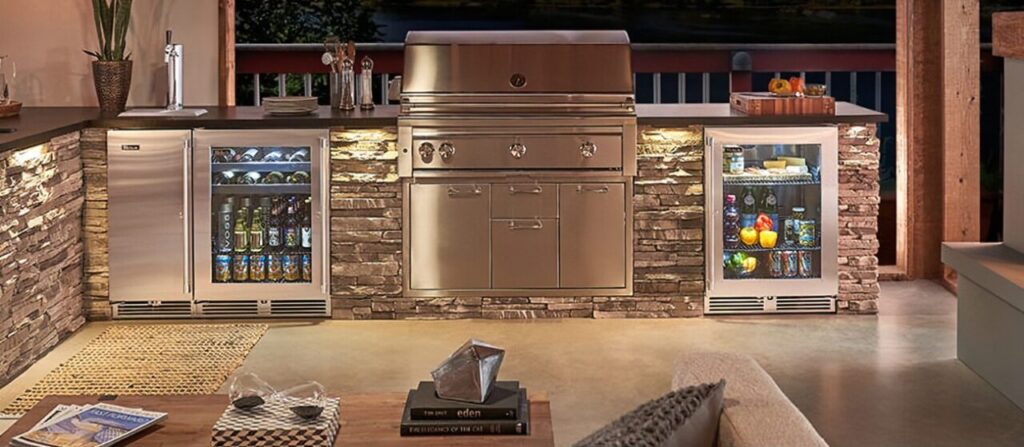If you’ve invested in an amazing outdoor kitchen setup, you’ll want to take it to the next level by adding refrigeration.
An outdoor refrigerator keeps fresh foods and beverages chilled right where you need them – steps away from your grill and prep areas.
Imagine the convenience of not having to make multiple trips inside during your backyard barbecues and parties.
With an outdoor refrigerator, you can keep everything from steaks to salads to beer and wine conveniently located in your outdoor oasis, just steps away from your grill and prep areas.
Outdoor refrigerators are not just a luxury addition to your outdoor entertaining space, they are a durable investment.
Specifically designed to withstand extreme temperatures and weather elements, they are built to last.
In this blog post, we’ll cover all the key considerations for finding the perfect outdoor refrigerator for your outside kitchen, ensuring you make a smart and long-lasting choice.
Types of Outdoor Refrigerators
When it comes to outdoor refrigerators, you’ll find a few different styles and configurations to choose from. The main options are compact, built-in, and freestanding units.
Compact Outdoor Refrigerators
As the name implies, compact outdoor refrigerators are perfect for small outdoor kitchens or patios with limited space.
These space-saving models generally have a capacity between 4 and 5 cubic feet. Despite their size, many compact units still offer a flexible layout with glass shelving, door racks, crispers, and even ice makers in some cases.
Their small footprint makes it easy for them to fit into tight areas.
Built-In Outdoor Refrigerators
Built-in refrigerators are designed to be tucked under counters or nestled between cabinetry for a seamless, integrated look. These high-end units come in various widths and have a polished exterior with professional-style handles and thick door seals.
Built-ins offer a premium sealed system to protect interior components from outside elements. Their ample storage and energy efficiency come with a luxury price tag.
Freestanding Outdoor Refrigerators
Freestanding models are a more affordable outdoor refrigerator style that can be moved around and relocated as needed.
Available in upright or cabinet designs, freestanding refrigerators are made of durable stainless steel or resin exteriors. They vary widely in size from compact to extra-large capacity.
Many models are designed with ventilation systems and weather-sealing to help them withstand sun, rain, and extreme temperatures outdoors.
Factors to Consider When Selecting an Outdoor Fridge
Climate/Weather Conditions
One of the most crucial factors to consider when choosing an outdoor refrigerator is its ability to withstand the climate where you live. This is especially important if you live in an area with extreme summers or winters.
Pay close attention to the model’s climate rating – is it approved for outdoor use in excessive heat, cold temperatures, humidity, or harsh precipitation?
Models specifically designed for outdoor use will be UV-resistant and have a durable, weatherproof exterior that can handle the elements.
If you live in an area with extreme summers or winters, you’ll want to opt for a fridge rated for those temperature ranges.
Size Needed
Another critical decision is what size or capacity you need for the outdoor refrigerator.
Measure the space you have cleared for the fridge and check that the model’s dimensions will fit properly with enough clearance for ventilation.
As for capacity, consider the common foods and beverages you’ll store to determine if you need a large 24-cu. ft. model or if a compact five cu. ft. refrigerator will suffice for your outdoor kitchen needs.
Desired Features
Like indoor refrigerators, outdoor models now come loaded with appealing features, from auto-defrost and LED lighting to adjustable shelving, crisper drawers, and door-mounted beverage racks.
Some units even offer ice makers, dual refrigerator/freezer sections, and dedicated beverage or wine chillers.
To narrow your search, make a list of must-have features versus nice-to-haves. Remember to account for noise levels if that’s a concern.
Ventilation Requirements
Proper ventilation is critical for an outdoor refrigerator to run efficiently and prevent overheating. Most models require several inches of clearance space around the unit’s sides, back, and top for adequate airflow.
Built-in refrigerators typically specify minimum clearances of 2-6 inches, while freestanding models need a bit more clearance, 6-10 inches. Take note of where the venting is located on the refrigerator (front, rear, side) and ensure you have enough space for it to exhaust warm air properly. Obstructing the vents can cause major problems, like warm interior temperatures or complete failure.
Power Requirements
Understanding the power requirements of outdoor refrigerators is essential for a successful installation. Most models require a standard 115V grounded outlet, but larger or premium models may need a dedicated 20-amp circuit. Always check the specifications to ensure you have the right power setup.
Budget Considerations
Finally, as you’d expect, outdoor refrigerators represent a significant investment compared to regular indoor models. At the high end are luxury built-in refrigerators that cost $3,000-$6,000 or more installed.
You get maximum insulation, weather resistance, storage capacity, and features at that premium price.
More affordable freestanding outdoor refrigerators average $500-$2,000, with smaller compact models on the low end and larger freestanding models with more amenities on the higher end.
When pricing them out, consider your available space, likely usage, desired features, and overall outdoor kitchen budget.
Tips for an Outdoor Kitchen on a Budget
Backyard Renovation Ideas For 2020 That Will Increase Property Value


